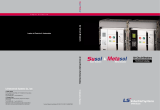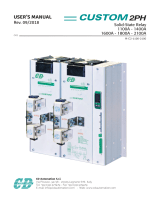Eaton Digitrip RMS 310+ trip unit for use Operating instructions
- Type
- Operating instructions
Eaton Digitrip RMS 310+ trip unit for use with R-frame breakers is an electronic trip unit that incorporates a microprocessor-based custom application specific integrated circuit design. It provides true RMS current sensing for proper correlation with thermal characteristics of conductors and equipment. The trip unit is suitable for 50/60 Hz AC applications and is available in 4 different types, each containing an adjustable long delay time function and may be equipped with a maximum of two phase and two ground fault protection functions (time requirements).
Eaton Digitrip RMS 310+ trip unit for use with R-frame breakers is an electronic trip unit that incorporates a microprocessor-based custom application specific integrated circuit design. It provides true RMS current sensing for proper correlation with thermal characteristics of conductors and equipment. The trip unit is suitable for 50/60 Hz AC applications and is available in 4 different types, each containing an adjustable long delay time function and may be equipped with a maximum of two phase and two ground fault protection functions (time requirements).












-
 1
1
-
 2
2
-
 3
3
-
 4
4
-
 5
5
-
 6
6
-
 7
7
-
 8
8
-
 9
9
-
 10
10
-
 11
11
-
 12
12
Eaton Digitrip RMS 310+ trip unit for use Operating instructions
- Type
- Operating instructions
Eaton Digitrip RMS 310+ trip unit for use with R-frame breakers is an electronic trip unit that incorporates a microprocessor-based custom application specific integrated circuit design. It provides true RMS current sensing for proper correlation with thermal characteristics of conductors and equipment. The trip unit is suitable for 50/60 Hz AC applications and is available in 4 different types, each containing an adjustable long delay time function and may be equipped with a maximum of two phase and two ground fault protection functions (time requirements).
Ask a question and I''ll find the answer in the document
Finding information in a document is now easier with AI
Related papers
-
Eaton Digitrip RMS 310 User manual
-
Eaton 520M Operating instructions
-
Eaton NRX Digitrip 1150 Owner's manual
-
Eaton Magnum IEC Series Technical Product Manual
-
Eaton Cutler-Hammer Digitrip 1150 Instructions Manual
-
Eaton Cuttler-Hammer Digitrip 1150V Owner's manual
-
Eaton KES 310+ Owner's manual
-
Eaton Digitrip RMS 910 Instruction Leaflet
-
Eaton Digitrip RMS 610 Trip Unit Owner's manual
-
Eaton Digitrip RMS 310 Instruction Leaflet
Other documents
-
WEG UBW Molded Case Circuit Breakers User manual
-
GW Instek tware Quick start guide
-
Eaton Electrical I.B. 29C892B User manual
-
Siemens SJD6-B User manual
-
WEG Molded Case Circuit Breakers UBW1200 User manual
-
Gewiss GWD9572 Technical characteristics
-
WEG Molded Case Circuit Breakers UBW2500 User manual
-
 LS Industrial Systems Metasol Series Technical Catalogue
LS Industrial Systems Metasol Series Technical Catalogue
-
ABB SACE Emax Instructions For Installation And Service
-
 CD Automation CUSTOM 2PH User manual
CD Automation CUSTOM 2PH User manual













